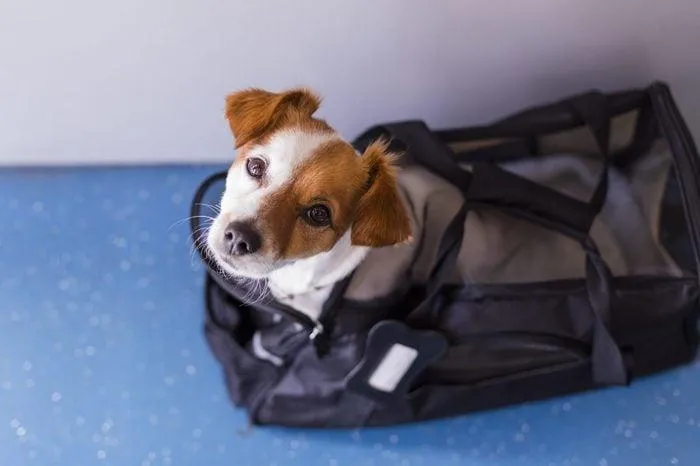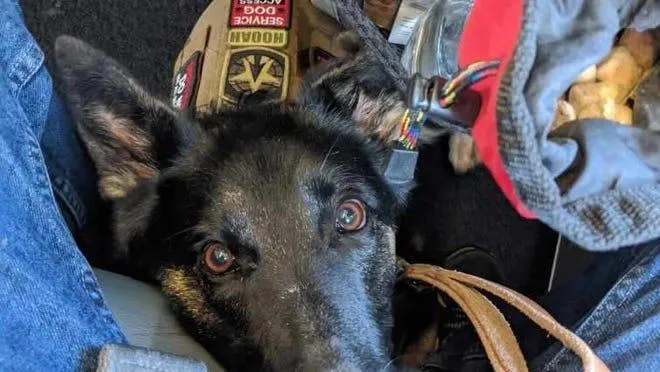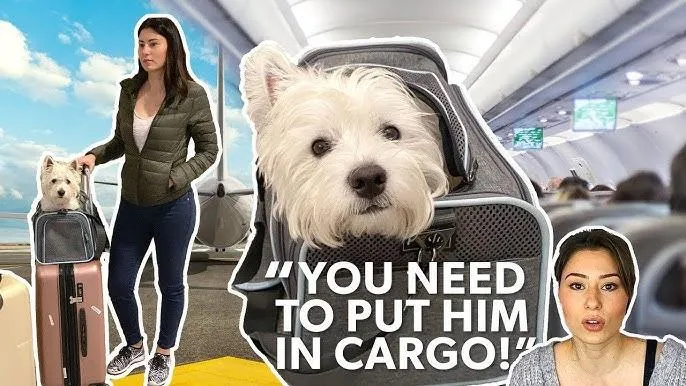A Comprehensive Guide to Flying With Your Dog in the Cabin
If you’re planning a trip that involves air travel and want to bring your furry friend along, flying with a dog in the cabin is definitely possible – but there are some important things to know first. In this article, I’ll cover all the key considerations and answer the most common questions owners have about bringing Rover on board.
Is My Dog Allowed in the Cabin?
The first step is making sure your dog is eligible to travel in the passenger cabin rather than the cargo hold. Most domestic US airlines allow dogs under 20 pounds to fly in the main cabin, but size and breed restrictions do vary by carrier. It’s a good idea to check the pet policy for your specific airline well in advance of booking your tickets.
From my experience traveling with dogs, some carriers like Delta and Alaska Airlines have more lenient policies than others. If your pup is over the size limit, you’ll need to check if they can fly as cargo instead. Either way, be prepared for potential pet fees that can range from $125-250 each way.
Reserving a Ticket and Crate
Once you confirm your dog meets the size criteria, the next step is booking their ticket at the same time you purchase your own. Many airlines allow one pet per passenger traveling, and spaces fill up fast – especially around holidays. I learned the hard way it’s best to reserve early.

You’ll also need an plastic or fabric pet carrier or crate that fits under the seat in front of you. Make sure it’s sturdy, ventilated, and big enough for your dog to stand up and turn around in comfortably.
What Documents Are Required?
- Proof of current rabies vaccination from your vet
- An airline-approved health certificate issued within 10 days of travel if flying internationally
- Possible microchip identification depending on the carrier
I advise keeping all paperwork together in a folder for easy access at check-in. Airlines can deny boarding if any required documents are missing or expired. It’s safer to prepare well in advance rather than relying on last-minute fixes.
What Can I Bring for My Dog?
While space will be limited, here are some essential items to pack in your dog’s carrier:
- Comfortable blanket or toy for reassurance
- Adequate supply of water in sealed containers
- Several small bags of treats to keep them occupied
- Pee pads in case of emergencies during flights
- Collapsible bowls for food and water
Avoid bringing bulky beds or extra clothes. Stick to only what your pup truly needs to stay happy and healthy on the journey. The less stuff, the better chance it all fits!

How Should I Prepare My Dog?
To help avoid stress and anxiety, it’s crucial to get your pup acclimated to flying before the big day. Here are a few things that worked for me:
- Practice short car rides with their carrier so it feels like a den
- Slowly introduce loud noises like vacuums or blenders near the carrier
- Give calming treats or supplements at the vet’s recommendation
- Don’t feed a big meal right before flying to prevent motion sickness
On travel day, aim to arrive at the airport early with plenty of time to check in. A tired or hungry dog will only make the process more difficult. Keeping them well-rested and relaxed is key.
What Should I Expect During Boarding and Flight?
Boarding with a dog in tow is a process, so be prepared for additional waiting and paperwork checks at the gate. I’ve found it’s smoothest if you’re polite, patient, and have all documentation ready to show staff right away.
Once on board, most airlines require pets to remain in their carrier under the seat or beside you for the entire flight for their safety. Don’t be tempted to let them loose even if they beg – it risks accidents or injuries from turbulence. Offer treats and reassurance during takeoff and landing when they may feel extra stressed.

If traveling internationally, inquire about quarantine procedures for your destination country before departing. Failure to plan accordingly could result in delays or extra costs upon arrival with your pup.
How Can I Prepare for Any Issues?
Despite your best efforts, flying isn’t always comfortable or seamless for dogs. Here are some final tips:
- Bring extra disposable bags, paper towels and cleaning supplies to handle accidents
- Consult your vet about calming supplements if anxiety is a concern
- Notify the airline ahead of time about any special needs like medications
- Consider pet travel insurance in case of delays, lost paperwork, illness etc.
With thorough preparation and patience, you greatly increase chances of a smooth flight with Fido. But remember, safety should be the top priority – even if that means finding alternative travel plans if they seem truly distressed. Your pup’s well-being comes first.
I hope this guide has helped address any questions about bringing your furry companion along in the passenger cabin. Safe travels to you and your dog! Let me know if you have any other questions.

Traveling by Air Cabin with Your Dog
| Airline | Size Restrictions | Crate Requirement | Fees |
|---|---|---|---|
| Delta | Under 20 lbs, must fit in carrier under the seat | Hard-sided carrier required | $125 each way |
| American | Under 20 lbs, must fit in carrier under the seat | Soft-sided carrier acceptable | $125 each way |
| United | Under 20 lbs, must fit in carrier under the seat | Hard-sided carrier required | $125 each way |
| Alaska | Under 20 lbs, must fit in carrier under the seat | Soft-sided carrier acceptable | $125 each way |
| JetBlue | Under 20 lbs, must fit in carrier under the seat | Soft-sided carrier acceptable | $100 each way |
FAQ
- Can I bring my dog on the plane in the cabin?
Most major airlines allow small dogs or cats to fly with owners in-cabin, provided they meet guidelines for size and behavior. Although some carriers have limits, most accept dogs under 20 pounds as cabin pets. - What documents do I need for my dog to fly in the cabin?
You will need to present either a vaccination certificate or health certificate stating your pet has received all required shots. A travel kennel is also necessary that can fit under the airplane seat in front of you. In addition, most carriers require you to purchase a ticket for your furry friend. - Does my dog need any training to fly in the cabin?
It sure helps if your pup has been trained and is cool with staying still for long periods. While not absolutely necessary, practicing staying calmly in a crate or kennel can make the cabin ride a lot smoother for both of you. Training equips dogs with important manners that help everyone feel comfortable onboard. - Is it super stressful for dogs to fly inside the plane?
Potentially yeah, the experience could kinda freak some dogs out with all the unfamiliar noises and movement. However, with proper prep like getting used to their kennel and smells onboard, most pups handle it just fine. As long as they remain calm and don’t bark a lot, chances are they’ll sleep through much of the flight anyways.
Additional Questions
- What if my dog acts up or barks while onboard?
If they cause problems that disturb others, you basically run the risk of being asked to leave the plane with your pup. Airline staff will give warnings first, but repeated issues mean you’d have to check your dog into the cargo hold instead. So it’s worthwhile to train the doggo to remain reasonably well-behaved. - Are there any size restrictions when flying with a dog?
Generally most carriers set a size limit where the pet must be able to sit comfortably on your lap within its carrier. The container also can’t take up space needed for other passengers. Perhaps take a measuring tape to be sure your pup’s living space complies with requirements. - Is it more expensive to bring a dog on the plane?
Indeed, in addition to the pet ticket, you’ll pay a fee which changes depending on the airline. However, for anxious pets or bigger dogs that can’t sit in the cabin, it might be worth the investment versus shipping them as cargo. Ultimately the costs must be weighed against everyone’s travel comfort.
On the other hand, flying with pets in-cabin does have some advantages over cargo if properly planned. Your buddy stays right with you so it’s less stressful than being kenneled alone below. It can be totally doable for many well-trained dogs. However, there are always risks so it pays to research airline policies in depth before takeoff. At the end of the day, you know your pup best – only you can decide what option aligns with their personality and needs.
